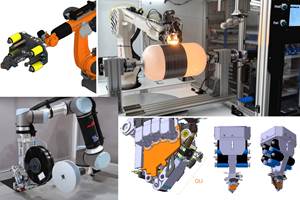Composites extensively used in Air Force communication tower
The tower was fabricated by Composite Support & Solutions using Ashland Derakane vinyl ester resin designed for pultrusion.
Composite Support & Solutions (CSSI, San Pedro, Calif) recently won a Tibbett’s award from the Small Business Administration for a 118-foot communications tower, which was completely made out of composites, and installed by the Air Force at Hanscom AFB in Massachusetts. The tower was fabricated by CSSI using Ashland (Dublin, Ohio) Derakane vinyl ester resin designed for pultrusion. Clement Hiel, CSSI’s founder and president, received the award at a ceremony at the White House on January 10th.
The prototype tower uses fastener-less joining technology where individual components, such as the lattice cross members, “snap” together during the assembly process without the need for metallic bolts.
Corrosion is currently the major cost driver in the maintenance of communication towers throughout the Air Force inventory. This has created a prevalent need for the Air Force to address corrosion-related issues, fueling the drive to discover innovative corrosion-resistant materials.
Composite Support & Solutions’ tower is being touted as the first of a new generation of tall composite towers that have the distinct advantage of being free from corrosion, significantly reducing long-term maintenance costs, while offering dramatically shortened construction times.
The Tibbetts Award honors the SBIR/STTR program participants and supporters that have created a significant economic or social impact through the use of SBIR/STTR funding.
“CSSI’s snap-join approach is an enabling technology for the fabrication of modular composites. There is great interest these days in lightweight, easy-to-assemble, easy-to-disassemble materials, and as such, this award-winning technology should spur widespread interest in the automotive, aerospace, and building and construction industries,” says Joe Fox, director of emerging and external technologies for Ashland.
Because the snap-fit system enabled quick assembly, the tower was erected adjacent to the Hanscom Collaboration and Innovation Center in about one-eighth the time that would have been required with metal, tallying significant cost savings. The tower now provides significantly improved line-of-sight capability for the center, extending its communication range and enhancing its overall mission effectiveness while eliminating the need for roof-mounted antennae and the problems associated with that type of solution. “Cost and time resource reductions help our procurement activities to deliver fully vetted tactical systems to the warfighter faster,” says Steve Brown, lead associate for the Tactical Data Networks Lab at Hanscom.
In the coming years, the tower is expected to support a growing number of uses for first responders and law enforcement, thanks to an investment by the State of Massachusetts. The Air Force and other federal agencies should see a significant benefit from the
new technology. But snap-together towers also are expected to generate widespread commercial appeal among mobile service providers and make it easier to erect towers quickly
in areas where catastrophic events
have occurred.
CSSI continues to innovate as well. The company has introduced a product trademarked as The Intelli-Firewall, a solution for containing fires in major substations caused by transformer malfunctions. Consisting of modular panels of a ceramic composite supported by steel columns, the easily-assembled walls, typically 10.8m by 10.8m in size, can isolate and protect large electrical equipment reportedly for more than 4 hours of continuous hydrocarbon re exposure, says the company. Panels also can be custom-manufactured to meet unique requirements.
Check out this video highlighting the project:
Related Content
Plant tour: Aernnova Composites, Toledo and Illescas, Spain
RTM and ATL/AFP high-rate production sites feature this composites and engineering leader’s continued push for excellence and innovation for future airframes.
Read MoreComposites end markets: New space (2025)
Composite materials — with their unmatched strength-to-weight ratio, durability in extreme environments and design versatility — are at the heart of innovations in satellites, propulsion systems and lunar exploration vehicles, propelling the space economy toward a $1.8 trillion future.
Read MoreThe next evolution in AFP
Automated fiber placement develops into more compact, flexible, modular and digitized systems with multi-material and process capabilities.
Read MoreActive core molding: A new way to make composite parts
Koridion expandable material is combined with induction-heated molds to make high-quality, complex-shaped parts in minutes with 40% less material and 90% less energy, unlocking new possibilities in design and production.
Read MoreRead Next
Ultrasonic welding for in-space manufacturing of CFRTP
Agile Ultrasonics and NASA trial robotic-compatible carbon fiber-reinforced thermoplastic ultrasonic welding technology for space structures.
Read MoreCutting 100 pounds, certification time for the X-59 nose cone
Swift Engineering used HyperX software to remove 100 pounds from 38-foot graphite/epoxy cored nose cone for X-59 supersonic aircraft.
Read MoreCeramic matrix composites: Faster, cheaper, higher temperature
New players proliferate, increasing CMC materials and manufacturing capacity, novel processes and automation to meet demand for higher part volumes and performance.
Read More












